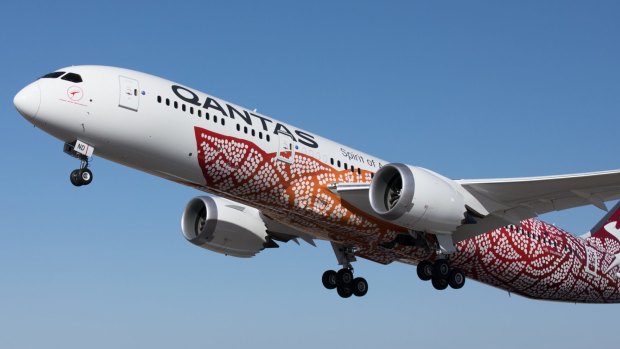This was published 5 years ago
London to Perth non-stop flights: Scientists baffled by passenger who didn't get up for 17 hours
By Annabel Fenwick Elliott
The first direct, non-stop flight from London to Perth launched in March, and with it an endurance test for passengers who must spend 17 hours straight cooped up on a plane. So imagine scientists' surprise, while recently studying their habits, when they encountered a man who did not leave his seat for the entire journey.
Researchers at the University of Sydney have been monitoring volunteers aboard the lengthy Qantas service since it started and were astounded by the behaviour (or lack thereof) of the unnamed passenger in question.
"The one thing we couldn't believe was how little [he] moved," said Professor Stephen Simpson from the Charles Perkins Centre, a division of the university, confirming that the subject took absolutely "zero steps".
The man was in business class and reportedly said he was so comfortable in the flat bed that he felt no need to move (yes, this sounds suspiciously like a marketing hoax from Qantas - but we're assured it isn't).
Is this normal?
No. According to Healthline, humans frequent the bathroom anywhere between four to ten times in a day; with the average being around six to seven times over a 24-hour period. What really enabled this super-long-haul flier to forgo the loo for 17 hours can only be speculated upon. Horse-strength sleeping pills? A phobia of locked doors? The genetic makeup of a camel?

The Qantas non-stop flight from London to Perth takes 17 hours.Credit: Brent Winstone
Isn't it dangerous to remain stationary on a plane?
Potentially. Staying still for prolonged periods of time during a flight puts you at a higher risk of developing deep vein thrombosis (DVT), which occurs when blood coagulates within the deep veins of the lower leg.
In the worst case scenario, a pulmonary embolism can follow when clots dislodge into the bloodstream and block blood flow through lungs, resulting in sudden death - as was suspected in the case of New Zealand rugby legend Jonah Lomu, who died of a blood clot shortly after getting off a long-haul flight from the UK to Auckland in 2015, at the age of just 40.
Dr Richard Dawood, a specialist in Travel Medicine at the Fleet Street Clinic, advises: "Keeping mobile gets blood flowing and prevents clots, so tense and relax your calf muscles frequently, and stand, stretch or walk around the cabin at least once every hour.
"Avoid sitting in the same position for a prolonged period, set alarms to remind you to move about, and don't take sleeping pills unless you are able to sleep in a fully flat position."
Lucky for the man with the iron-clad bladder, he was flying business class.
How are these passengers being monitored?
To gather the data, passengers who are part of the Qantas scheme are fitted with two medical grade devices that record sleep, physical activity and changes in posture - one on the wrist and the other on the thigh.
Subjects are also asked to complete questionnaires about their overall state of mind, food and beverage consumption, and how they feel before, during and after the flight, with the aim of collating information to help improve cabin conditions and manage jet lag.
Scientists conducting the study said it was too early to share any further observations made of passengers thus far, but prior research they've carried out on weary travellers has already shaped Qantas' newer offerings.
In March, ahead of the inaugural Perth to London Dreamliner service, the carrier unveiled its new Perth International Transit Lounge, with features including 'light therapy' in the shower suites to help adjust the body clock, and a wellbeing studio with stretching classes.
"We've also worked together to influence the menu and timing of the food and drinks service on the Perth to London route, as well as the cabin lighting design and temperature in the 787," said Professor of Sleep Medicine Peter Cistulli, of the Charles Perkins Centre.
See also: Qantas unveils new, jet-lag busting lounge for London non-stop flights
So has it made any difference?
Travel writer Nigel Richardson was on the inaugural London-Perth flight in March, along with 20 passengers who were rigged up to the aforementioned monitors, and wrote of the experience: "The cabin lighting [which has nine scenarios from sunrise to sunset] is designed to fool one's body clock into re-setting itself.
"But the most promising innovation from my point of view is the cabin atmosphere, which theoretically benefits from increased humidity (so your eyelids don't feel like sandpaper when you wake up) and a cabin pressure equivalent to a lower altitude."
He added: "I can honestly say I feel a lot fresher than I thought I would (and that's the consensus among the group I'm travelling with). Though it's possible of course that all this talk of melatonin, circadian rhythms and colour phases has simply had a placebo effect."
We will be following the outcome of further findings from the Charles Perkins Centre as and when they emerge.
Telegraph, London
See also: Airline review: Qantas Dreamliner's first non-stop Perth to London flight
See also: Singapore launches world's longest flight route no economy seats on plane
Sign up for the Traveller Deals newsletter
Get exclusive travel deals delivered straight to your inbox. Sign up now.